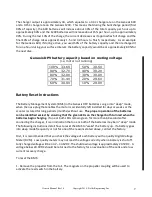
Genesis Manual Rev1.6 Copyright 2018, Nellis Engineering, Inc.
17
4. Install the test gauge into the test port only hand snug. Over tightening the fitting can
damage the anodizing and lead to corrosion at the test port.
5. Pressurize the DPV to 3-5 psi with a bicycle pump or similar.
Note
It is possible to have slight pressure changes during the pressure
test due to changes in temperature. Do not rely on visual gauge
indication of no pressure change, when ruling out a leak.
11. If a leak is suspected, the DPV should be immersed in water during the pressure test.
It will be significantly buoyant with the batteries removed.
12. When finished, vent the body with the relief valve on the gauge assembly and remove it.
Reinstall the test port plug and the screw for the battery connectors.
Data Loggers
If you wish to install a data logger to monitor power consumption, it will need to be configured per
the diagram below ( Fig. 10) The scooter voltage can be as high as 67.0V and the current as high
as 20A, so the data logger needs to be rated accordingly. You will need to make a jumper to
connect the two batteries in series. To avoid a high current spike on to the data logger, ensure the
circular connector is removed and plug the batteries into the tail section to charge up the
capacitors before installing the logger. Install the logger per the diagram, connecting it to the
batteries first ant the tail second before connecting the circular connector. You will not be able
the recharge the DPV with the data logger installed.
Figure 10 - Data logger connection diagram


















